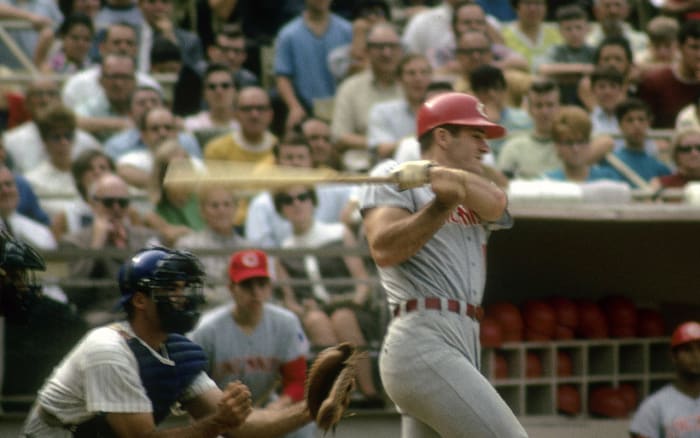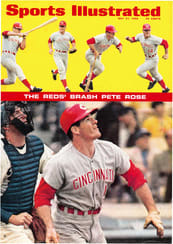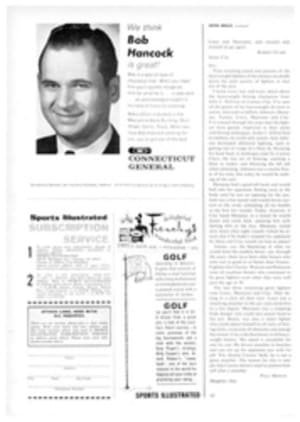Charlie Hustle Gives Twelve Dimes on the Dollar
The trouble with Charlie Hustle is that he is forever trying to make plays that cannot possibly succeed under the existing laws of either geometry or gravity or even in the minds of the 499 other major leaguers who play with or against him. On the second day of this season, for instance, Charlie, with only 10 days of spring training behind him, went to war against Billy Williams of the Chicago Cubs and the right-field fence at Crosley Field in Cincinnati. Williams had hit a ball that everyone knew was a home run. Charlie Hustle, however, believed that the ball could be caught, and he jumped as high as he could. The glove slipped off Charlie's hand and the jagged wires on the top of the fence impaled him. When he finally got everything disentangled, the hand looked like an open cherry pie. But that's Charlie for you. He gives 12 dimes on the dollar every time.
Charlie Hustle is Peter Edward Rose of the Cincinnati Reds, and at the end of last week he was leading the major leagues in hits, runs, batting average and uniforms dirtied. He was galloping around the bases and the outfield and making more quick starts and stops than a water bug on LSD. Also, at 26, he was finally starting to get the recognition he has deserved for the past three seasons. The public has come to realize that Rose is a genuine throwback to that time when it was considered a crime to look at a third strike, and The Sporting News, not the Wall Street Journal, was the player's bible.
Pete Rose is the type of person who would run to a funeral and, if he didn't like it, would boo the deceased. When he was asked last week why he still kept a crew cut and had not affected long sideburns as most players are doing this year, his brown eyes seemed to catch fire. He said "Because we have razors and barbers in Cincinnati." There is within him some rare form of self-propulsion that lifts him up to the peaks of imaginary mountains he builds in front of himself. Pete Rose does not want to remain just a mere $57,000 ballplayer for very long. "I want to be the first player who is not a 20-game winner or a big home-run hitter to make $100,000 a year," he says candidly.
The quick start Rose has fashioned for himself this season has put him ahead of schedule as he chases after 200 hits—one of the most respected professional accomplishments in baseball. Twice in five years Rose has gone over 200 hits and last year he might have made it for a third straight time had he not been out of the lineup with injuries for 14 games. In his last three seasons he has hit .312, .313, and .301. With the Reds he has been a regular at four different positions, playing second base, third base, left field and right, all with facility. But it is his hitting that interests Rose. "There is no doubt," he says, "that because I am a switch hitter I have one of the best offensive advantages that a hitter can have."
Basically those advantages come down to two: 1) the curveball is always breaking in on the switch hitter instead of away from him, and 2) a sidearm pitcher is no problem. The difference between a man who hits .280 and one who hits .300 is relatively small. Based on 500 at bats it comes down to only 10 hits for an entire season or, put more simply, less than one blooper or scratch hit every two weeks. Getting 200 hits is much more difficult than hitting .300. In most cases it means that the player has hit the ball well consistently, has batted in virtually every game and has been fast enough to beat out infield hits and bunts.
The American League has produced only two men in the last dozen seasons who have gotten 200 hits: Bobby Richardson and Tony Oliva. (Carl Yastrzemski had 189 last season.) During the same time 200 hits have been reached 29 times in the National League.
The practicing genius on getting 200 hits is Roberto Clemente of the Pittsburgh Pirates (see chart page 37). "It's tougher to reach 200 hits as you get older," says Clemente, now withering away at 33. He has managed 200 hits four times since 1955, three of them in the last four years. "I never realized how great 200 hits was until 1964," he says. "The thing about getting 200 hits is that you have to have a quick body, run good enough and be strong and run all the time. The young body is the main thing, and Rose has a young body. He has a short, smooth, quick swing, and he does not strike out much."
Henry Aaron, the hitting machine dressed in an Atlanta Braves' uniform, has had 200 hits three times in his career and knows the pressures that a hitter must go through to get 200. "It's awful tough nowadays," he says. "Heck, it's awful tough to get two hits a game. Six years ago, maybe. Not now. Rose's speed helps him, and the fact that when he hits left-handed he gets that extra jump to first base. I would say that Pete gets the bat on the ball more regularly than I do. I strike out more than he does. Confidence is the big thing that makes Rose a great hitter. He has a world of confidence in himself. If you didn't know him you'd think he was cocky. Rose believes that there isn't anybody who can get him out. He sets up certain goals for himself each year, and if he doesn't reach them he's awfully disappointed."
Often the men who try for 200 hits come down to the end of the season with pressures felt only by themselves. Lou Brock and Curt Flood of the St. Louis Cardinals, who twice had 200 hits, realize that. The first time that Brock did it, the 200th came in the sixth inning of the final game of the season; Flood got his 200th hit in the 14th inning of the last game of the 1963 season.
Flood, the man currently closest to Rose in hits this season, says, "You have to play virtually every game. You have to have consistency, and you can't afford any 0-for-20 slumps. You need hot hitting streaks."
In the spring of 1963 Pete Rose arrived at the Reds' training camp in Tampa and, seemingly, did not have a chance to make the club. He was on the roster of the Reds No. 1 farm team at San Diego, and that is where everyone except Rose expected him to play. "He came to camp," says Jim Maloney, Cincinnati's best pitcher, "and all we knew was that he had had a great year in Macon and had a reputation for running hard as he could to first base on walks."
The man who had managed Rose in Macon was Dave Bristol, now the colorful manager of the Reds. "The first time I saw Rose," Bristol says, "I kind of sat back and watched him running all the time to everywhere. I asked myself, 'Is he putting me on with all this razzmatazz, or is he real? Is it going to be like this all the time?' Well, it was! He never gave up all year—not once on anything. He hit .330 and led the league in triples and runs scored. We had a catcher at Macon named Larry Himes, and he was having his troubles throwing. Balls would go over the heads of Rose and Tommy Helms around second base or just plain wild and wide and into center field. All the time Himes would be yelling at Rose and Helms, "Pick me up; you gotta pick me up!" One day I came out to the park and Himes was catching batting practice, and there were Rose and Helms on second base. They had a stepladder and Rose was up on the top of it and Helms halfway up, and they were hollering, "Pick us up, Larry; pick us up!"
At that first major league camp Rose was everywhere. One night, as the late Fred Hutchinson, then manager of the Reds, sat at the bar of the Causeway Inn in Tampa, he glanced out through the glass door and who should be looking in but Pete Rose. Hutch laughed and slapped his fist on the bar. "He's everywhere," he said. "I see him awake, I see him asleep and now I see him peeking in bar windows. Rose! Pete blank-in' Rose."
Hutch and Rose were two of the three people who gave Rose a chance to remain with Cincinnati in that spring of 1963. One afternoon Rose hung around to watch an exhibition game when he could have left the ball park early with others who were not needed that day. Hutchinson noticed Rose and stuck him in as a pinch runner. Rose stayed in the game, it went into extra innings and in the 11th inning Pete came to bat and doubled. In the 14th he doubled again and scored the only run in a 1-0 victory. He was beginning to make himself unavoidably noticeable. When the Reds played the New York Yankees in an exhibition game Whitey Ford and Mickey Mantle stood on the sidelines and watched Rose running around in pre-game practice. Their conversation went something like this: "What's that thing supposed to be?" "One of the funniest things I ever saw." "Who the hell is he?" "Pete who?" "I got a name for that thing," said Ford. "That's Charlie Hustle."
For all of Rose's hustle, those watching the Reds that year were certain that he would be sent down for more seasoning. Earl Lawson of the Cincinnati Post and Times-Star took a poll of players, asking them to write down the names of the men they thought would stick with the club. The only person to include Rose was Don Blasingame, the player Rose ultimately replaced at second base when the season opened.
Had Rose been polled, he certainly would have written down his own name. Pete Rose is a young man who is very sure of his ability. One night in Tampa, Coach Dick Sisler saw Rose hitchhiking on the road back to the team's hotel. "What were you hitchhiking for?" asked Sisler. "Well," said Rose, "I haven't got a car and you don't expect a major leaguer to walk, do you?" Despite a bad start Rose ended his first season with a .273 average and was named as the National League's Rookie of the Year.
Although Rose has twice reached 200 hits, the first thing people notice about him is that penchant for running, not walking, to first base when he is passed. The other afternoon at New York's Shea Stadium a stopwatch caught Rose running to first on a walk in 3.8 seconds; most of the other walkers took about eight seconds. "Pete Rose," says Gene Mauch, the manager of the Philadelphia Phils, "is the kind of ballplayer every manager likes to manage. He's not afraid to get tired, he's proud of the things he can do well, he's proud of being the game's top hustler and he goes out to try to prove everyday that his reputation is justified."
The idea of running out his walks came to Pete Rose one day at the two-story home in the comfortable, old-fashioned Anderson Ferry section of Cincinnati where his family has lived for 33 years. The immediate stimulus was Enos Slaughter. The real reason may have been Pete's father.
Pete Rose Sr., now 56, was a famous athlete in Cincinnati. Although he played no organized football in high school or college, he was a member of the Cincinnati Bengals in a tough semipro league and, in fact, at the age of 42 he was still considered the best halfback in the league. Among his other accomplishments he ran the 100-yard dash in 10.5 seconds. At the end of football games, no matter how tired or bruised he was, Pete Rose Sr. always ran up the hill to his house in Anderson Ferry just to show that he could do it. Mr. Rose had a brief, successful boxing career under the name of Pete Sams and was a stablemate to Freddie Miller, once the world featherweight champion.
One day when the two Petes were watching television the youngster saw Slaughter of the Cardinals come to bat against the Reds. "Slaughter drew a walk," says young Pete, "and he ran hard to first base. I decided right then that that was what I was going to do as long as I played ball." When Pete did it in the minor leagues he often heard catcalls from enemy dugouts. "They called me Hot Dog and Hollywood," he says, "but nobody hollers at me in the major leagues."
Rose once maintained that "we were so poor when I was a kid that I had a sister who was stamped, 'Made In Japan.' " This was a typical reverse exaggeration. Rose has two sisters and a brother. His father, who has been with the Third Union Trust Company for 38 years, is now an assistant cashier. Pete Sr. met his wife at a ball game. "My wife," he says, "was a pretty good ballplayer, too. I think Pete gets his native baseball ability from her side of the family. His mannerisms are like my wife's older brother's, Buddy Bloebaum, who was a shortstop." It was Buddy Bloebaum, then a Red scout, who signed Rose to a Cincinnati contract.
"When somebody wants to interview me," Rose has said, "I've always got something to say." He does, and if nothing else it is original. When he was told that he was going to be switched to the outfield in 1967 he said, "That's fine. We had to integrate in some way." Before going on a tour of Vietnam this past winter with Joe DiMaggio, Ernie Banks, Lefty Gomez and Bob Fishel, who is the publicity director of the New York Yankees, Rose, a private in the reserves, explained, "While I'm in Vietnam I'll wear a colonel's insignia. As I understand it, you've got to have a rank just in case you are captured. Otherwise they can accuse you of being a spy."
Before the start of this season Rose first held out for a higher salary, then fulfilled part of his reserve obligation. This explains why he had only 10 days of spring training. "I felt awful," he says, "and when the start of the season was delayed because of the assassination of Dr. Martin Luther King, I came out to the ball park and took extra batting practice for hours. I don't know how many hours, but until it got dark. Then I got off slowly the first day and the next day got my hand hung up on the fence."
Beginning with the season's third game, however, Rose went on a 22-game hitting streak in a year that so far has produced comparatively little hitting. His streak was stopped in Philadelphia when he had three line drives caught. Last season Rose put together a 25-game streak, was stopped for one game and then went on another 11-game tear. "The streaks," he said last week. "Gotta get some more streaks if I'm going to get those 200."
"The thing about Rose," says Maloney, "is that he's always on the move, always up to something. In my opinion, he and Roberto Clemente and Lou Brock are the three most exciting players in the game. If there were more players around like them it would be a great thing for baseball."
Rose is a hyperactive, all-round athlete. He played football well enough in high school to be offered scholarships. During this past winter he played basketball in four different industrial basketball leagues. "I'm a passer and a rebounder," he says, "but Oscar Robertson and Jerry Lucas don't have too much to worry about. I love basketball, and it helps me to keep in shape, especially since I'm not one of those guys who believes in lifting weights. Back in 1960 at Christmas time I did work loading and unloading boxcars for Railway Express. That was a kind of weight training that helped me. I weighed about 160 when I started. I began to gain weight and kept right on gaining until I reached 195 pounds. That's what I play at now."
Rose is married to the former Karolyn Ann Englehardt and has a 3-year-old daughter named Fawn Renee. He also has a 19-year-old brother, Dave, who has signed with the Reds and, according to Pete's father, "has equal natural ability. At the same age he's able to hit the ball farther than Pete, and he's bigger than his older brother. But he doesn't have the go-go spirit Pete's got. Pete's gung-ho on everything."
[originallink:10543381:42999]
PHOTO
DURING FLIGHT, IRREPRESSIBLE ROSE PLAYFULLY MUSSES MANAGER
BRISTOLTWO PHOTOSA FAMILY MAN, Rose likes to swap stories with father Pete and brother Dave in clubhouse, even submits cheerfully to haircut by wife Karolyn Ann. He is holding daughter Fawn Renee.


